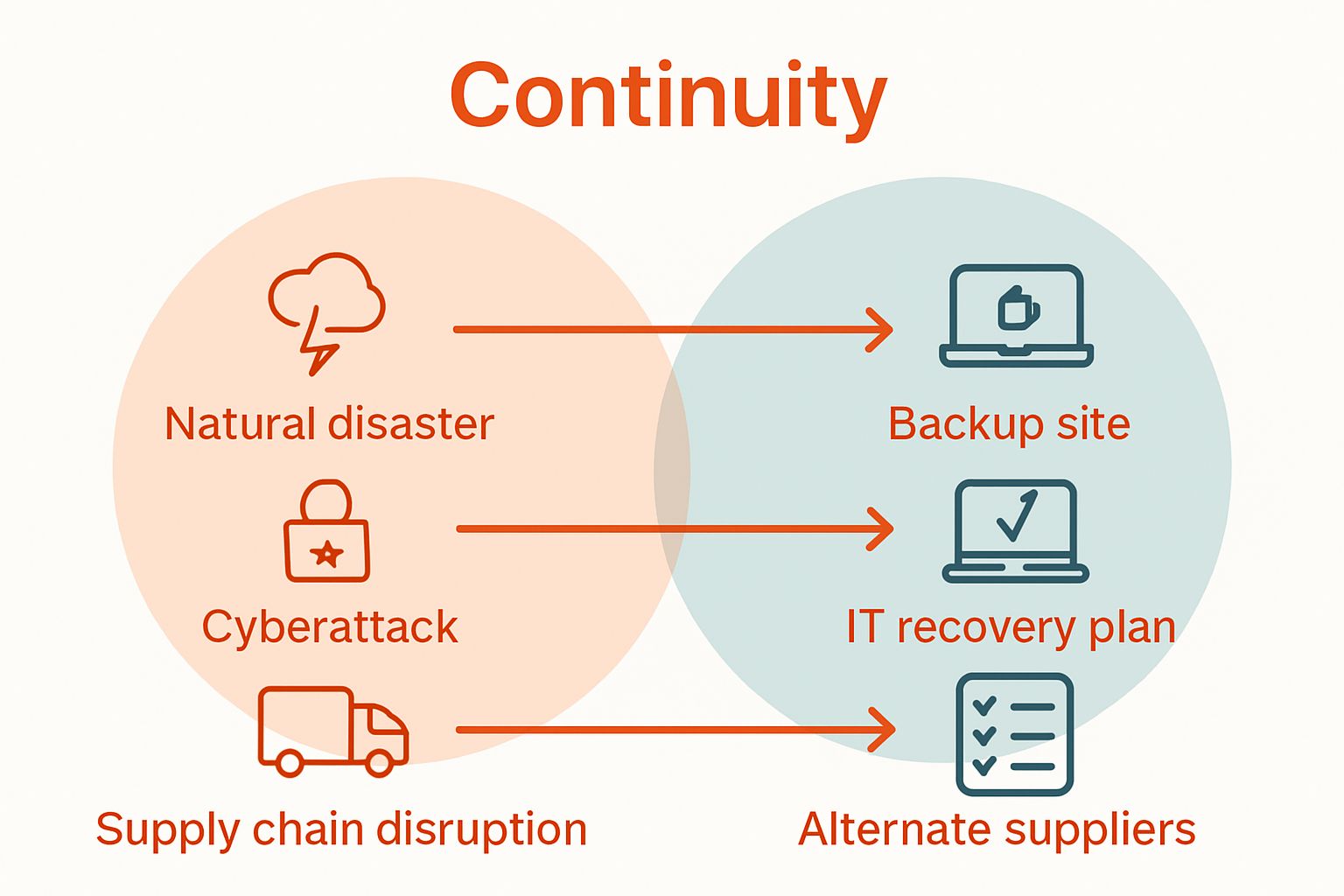
Understanding Business Continuity Strategies for Resilience
Business disruptions strike out of nowhere and can bring even the most organised company to a standstill. Across South Africa, up to 90 percent of businesses without a continuity plan never fully recover after a major incident. It sounds scary, right? The real surprise is that a well-planned strategy can turn the chaos of a crisis into a moment for your business to shine stronger than ever.
Table of Contents
- What Are Business Continuity Strategies?
- The Importance Of Business Continuity Strategies
- How Business Continuity Strategies Work
- Key Concepts In Business Continuity Strategies
Quick Summary
| Takeaway | Explanation |
|---|---|
| Comprehensive risk assessment is essential | Identify potential vulnerabilities to develop effective response plans. |
| Develop clear recovery protocols | Create structured actions for maintaining operations during disruptions. |
| Regularly test and update strategies | Ensure business continuity plans remain effective in changing circumstances. |
| Protect core functions to sustain operations | Maintain critical processes and revenue streams during unexpected events. |
| Foster interdepartmental collaboration | Engage all departments for a comprehensive approach to business continuity. |
What are Business Continuity Strategies?
Business continuity strategies represent comprehensive, proactive approaches organisations develop to maintain critical operational functions during unexpected disruptions. Business continuity planning enables companies to anticipate potential challenges and design robust frameworks that protect their core business processes.
Core Components of Business Continuity
At its fundamental level, business continuity strategies encompass systematic plans designed to ensure an organisation can continue functioning during and after significant interruptions. These strategies are not merely reactive measures but strategic blueprints that identify potential risks, critical operational dependencies, and recovery mechanisms.
Below is a comparison table highlighting the core components of business continuity strategies and their key features as discussed in the article.
| Component | Description |
|---|---|
| Risk Assessment | Systematic identification and evaluation of potential vulnerabilities within the organisation |
| Documentation of Business Functions | Detailed recording of essential operations and their interdependencies |
| Recovery Protocols | Clear instructions for maintaining and restoring core functions during disruptions |
| Emergency Response Procedures | Predefined steps for immediate action in the event of a disruption |
| Cross-Departmental Collaboration | Engagement between departments to ensure comprehensive and coordinated strategies |
| Regular Testing and Updating | Ongoing review and adjustment of strategies to stay relevant against emerging risks |
Key aspects of business continuity strategies include:
- Comprehensive risk assessment and identification of potential operational vulnerabilities
- Detailed documentation of essential business functions and their interdependencies
- Development of clear recovery protocols and emergency response procedures
Strategic Planning and Implementation
Effective business continuity strategies require meticulous planning and cross-departmental collaboration. Business leaders must develop comprehensive frameworks that account for various potential disruption scenarios, ranging from technological failures to natural disasters. By reading more about our IT service continuity guide, organisations can gain deeper insights into creating resilient operational strategies.
The primary goal is to minimise potential downtime, protect critical business assets, and ensure rapid recovery. This involves creating detailed contingency plans, establishing communication protocols, and regularly testing and updating the strategy to maintain its effectiveness in an ever-changing business landscape.
Ultimately, business continuity strategies transform potential vulnerabilities into structured, manageable risks, enabling organisations to respond with agility and precision when unexpected challenges emerge.
The Importance of Business Continuity Strategies
Business continuity strategies are not merely optional precautions but critical safeguards that protect organisations from catastrophic operational disruptions. Research from business impact analysis experts demonstrates that companies with robust continuity plans significantly reduce their financial and reputational risks during unexpected events.
Protecting Organisational Sustainability
The fundamental importance of business continuity strategies lies in their ability to preserve an organisation’s core functions during challenging circumstances. These strategies act as comprehensive shields, enabling businesses to maintain critical operations, protect revenue streams, and sustain stakeholder confidence even when confronted with significant disruptions.
This table summarises the key reasons why business continuity strategies are vital for organisational sustainability, supporting the points mentioned in the article.
| Key Reason | Description |
|---|---|
| Minimising Financial Losses | Reduces direct and indirect costs during operational interruptions |
| Maintaining Customer Trust | Ensures uninterrupted service delivery and upholds reputation |
| Ensuring Regulatory Compliance | Helps meet statutory and legal requirements during disruptions |
| Preserving Competitive Market Positioning | Maintains business operations and relevance in the eyes of stakeholders |
Key reasons why business continuity strategies are crucial include:
- Minimising financial losses during unexpected interruptions
- Maintaining customer trust and service delivery
- Ensuring regulatory compliance and legal protection
- Preserving competitive market positioning
Strategic Risk Management
Effective business continuity strategies transform potential vulnerabilities into manageable risks. By proactively identifying potential threats and developing comprehensive response mechanisms, organisations can create adaptive frameworks that enable rapid recovery. Explore our detailed guide on disaster recovery planning to gain deeper insights into strategic risk mitigation.
Moreover, these strategies provide a structured approach to understanding and mitigating potential operational challenges. They enable leadership to make informed decisions, allocate resources effectively, and develop resilient organisational structures that can withstand unexpected disruptions.
Ultimately, business continuity strategies represent an investment in organisational stability, demonstrating a commitment to long-term sustainability and strategic preparedness in an increasingly unpredictable business environment.
How Business Continuity Strategies Work
Business continuity strategies operate through a systematic, multi-phase approach designed to ensure organisations can effectively respond to and recover from potential disruptions. According to international standards for business continuity management, these strategies follow a comprehensive framework that transforms potential risks into manageable operational challenges.
Risk Assessment and Identification
The initial phase of business continuity strategies involves conducting a thorough risk assessment. This critical process requires organisations to systematically identify potential vulnerabilities, evaluate their potential impact, and prioritise critical business functions. By mapping out potential scenarios and their potential consequences, businesses can develop targeted response mechanisms.
Key elements of the risk assessment process include:

- Comprehensive evaluation of internal and external threat landscapes
- Detailed analysis of potential operational dependencies
- Quantification of potential financial and operational risks
- Identification of mission-critical business functions
Development of Response Protocols
Once risks are identified, organisations develop detailed response protocols that outline specific actions to be taken during different disruption scenarios. These protocols serve as structured roadmaps, providing clear guidance on maintaining essential operations, communication strategies, and recovery procedures. Learn more about our comprehensive disaster recovery planning approach to understand how these protocols are developed and implemented.
The response protocols typically encompass multiple dimensions, including technological infrastructure recovery, personnel communication strategies, alternative operational sites, and resource allocation mechanisms. These comprehensive plans ensure that organisations can quickly adapt and respond to unexpected challenges.
Ultimately, business continuity strategies work by transforming potential uncertainties into structured, actionable plans that enable organisations to maintain operational resilience, protect critical assets, and rapidly recover from potential disruptions.
Key Concepts in Business Continuity Strategies
Business continuity strategies encompass a sophisticated framework of interconnected principles and methodologies that enable organisations to maintain operational stability during unexpected disruptions. According to business resilience research, these strategies represent a holistic approach to organisational risk management.
Critical Infrastructure and Resource Mapping
At the core of business continuity strategies lies the concept of critical infrastructure mapping. This involves comprehensively identifying and understanding the essential components that sustain an organisation’s core functions. These infrastructure elements go beyond physical assets and include technological systems, human resources, communication networks, and operational processes that are fundamental to maintaining business operations.
Key components of critical infrastructure include:
- Technological systems and digital infrastructure
- Communication and information management platforms
- Essential human resources and skill sets
- Financial and operational resources
- Supply chain and external dependencies
Operational Resilience and Adaptive Mechanisms
Operational resilience represents another fundamental concept in business continuity strategies. This principle focuses on an organisation’s ability to anticipate, respond to, and recover from potential disruptions. Resilience is not about preventing all possible challenges but developing adaptive mechanisms that enable rapid response and recovery. Discover more about our approach to operational resilience planning to understand how businesses can build robust, flexible frameworks.
Resilience involves creating flexible strategies that can quickly pivot and reallocate resources, maintain essential functions during crises, and minimise potential operational and financial impacts.
 This requires a dynamic approach that continually assesses and updates potential risk scenarios and response mechanisms.
This requires a dynamic approach that continually assesses and updates potential risk scenarios and response mechanisms.
Ultimately, key concepts in business continuity strategies revolve around creating intelligent, adaptive systems that transform potential vulnerabilities into opportunities for organisational learning and strategic improvement.
Strengthen Your Business with Reliable Continuity Solutions
You have learned how business continuity strategies help organisations protect critical operations and reduce risk during disruptions. Like many engineering or financial companies, you may worry about prolonged downtime, threats to sensitive data or the cost of recovery when your systems encounter unexpected failures. These are common concerns, especially when business resilience and uninterrupted service are essential to your reputation and bottom line.
Techtron understands your need for a proactive partner who not only anticipates IT challenges but also delivers tailored managed IT services that underpin true operational continuity. We specialise in helping South African firms implement robust disaster recovery, backup, cybersecurity and network protection frameworks. Looking for step-by-step disaster recovery insights? Visit our IT disaster recovery planning resource to see how your business can quickly bounce back after a crisis. Ready to secure your operations and give your team peace of mind? Start your journey with Techtron today and let us help you build lasting business resilience.
Frequently Asked Questions
What is a business continuity strategy?
A business continuity strategy is a proactive approach that organisations develop to ensure they can maintain critical operations during unexpected disruptions. To create one, identify essential functions and outline protocols for different disruption scenarios.
How can I conduct a risk assessment for my organisation’s continuity plan?
To conduct a risk assessment, evaluate potential internal and external threats, identify vulnerabilities, and prioritise critical business functions. Start by creating a detailed list of possible risks within the next 30 days to ensure a comprehensive understanding of your organisation’s exposure.
What key components should I include in my business continuity plan?
Your business continuity plan should include risk assessment documentation, recovery protocols, and communication strategies during disruptions. Develop these components systematically to ensure clarity and effectiveness, ideally within a 60-day timetable.
How often should I test and update my business continuity strategy?
You should test and update your business continuity strategy at least annually or after any significant operational changes. Schedule regular reviews every 12 months to ensure the plan remains relevant and effective against emerging threats.
What role do employees play in business continuity strategies?
Employees play a crucial role in executing business continuity strategies by adhering to established protocols and participating in training exercises. Engage your team in training sessions at least twice a year to enhance their understanding of roles during disruptions.
How can business continuity strategies help protect my organisation’s reputation?
Business continuity strategies can preserve customer trust and service delivery during disruptions, which is vital for maintaining your organisation’s reputation. Focus on clearly communicating your response strategies to stakeholders to reinforce confidence, aiming for transparency within 24 hours of an incident.